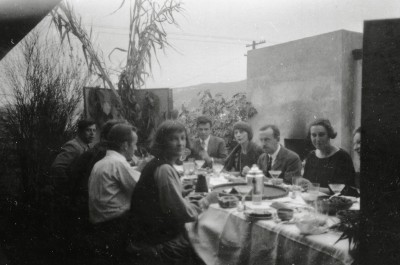This inner resonance of feeling is the experience of art.
—Galka Scheyer, 1923
This proposal pronounces the Kings Road House a pleasure palace. Teasing from its aged walls stories and mythical legends that once enlivened its spaces. Now an exquisite corpse, this early twentieth-century Californian masterwork returns to its sensual origins as a handful of contemporary visual artists draw from archival photographs and personal impressions to momentarily reestablish the spirit of a time past.
Conceived in the social and cultural context of bohemianism that swept California in the 1920s, its inhabitants celebrated unconventional cooperative living and working as two young families experimented with alternative lifestyles. Liberty prevailed, as Orgones (from orgasm and organism) were believed to improve health, sex, and happiness. Hence, the pursuit of emotional and physical satisfaction was central to the architectural agenda. In this light, the Kings Road House is a moody architecture that differs from the restrained rationalist agenda more often associated with modernist architectural expression.
The image below reflects Schindler’s advocacy of an alternative lifestyle, one built on new notions of communal living. It is ironic that there is little about the architecture today that resembles the past of collective living. By broadening the notion of what constitutes the “collective” to include spaces construed for the pleasure of human experience, our perception of the Kings Road House might be shifted—rather than being obscured by its own historiography, life is resuscitated through the eyes of contemporary artists.
The artists will use film as their medium, to retrace the boundaries of the architecture—breeding aspects of creative practice outside of the institution into the everyday. Drawing from a rich body of textual, archival, and circumstantial evidence, four Los Angeles filmmakers will each stage a performative event to construct a narrative about this architecture as a living environment. From the event, four revealing short films about one mythical place will be woven together to construct a single narrative. Four moments are fused by transitional sequences and bracketed by an introduction and epilogue to form a cinematic anthology. Each transition begins with the last shot of the previous film and ends with the first shot of the following film. Extending the atmospheric and experiential quality of the previous segment, this visual compendium offers a spatially charged glimpse into the mysterious character of communal life interlaced through the architecture of the Kings Road House.
Rather than screening the films directly at the house, the films will be globally disseminated using social media, including web-based and mobile technologies. A launch party with important historians, theorists, artists, and architects will be held at the Kings Road House, marking the film’s global distribution. Guests will be invited to view the films on their own mobile devices, leaving a desire to know more: more about the people, more about the artists, and more about the lifestyle its creators once embraced. The aim is to understand and appreciate the social and cultural context from which this architecture was born.

Thanksgiving at Kings Road, 1923. This photo by R.M. Schindler shows Herman Sachs, far left, others at table clockwise from Sachs include Karl Howenstein and Edith Gutterson, Anton Martin Feller, E. Clare Schooler (lover of Dorothy Gibling), person partially obscured at right (unidentified), Betty Katz, Alexander R. Brandner, unidentified, and Max Pons (obscured, to Sachs’s right).